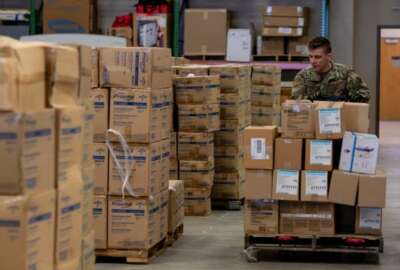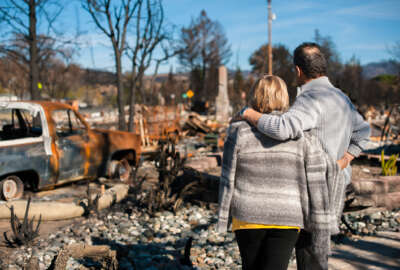Hubbard Radio Washington DC, LLC. All rights reserved. This website is not intended for users located within the European Economic Area.
The case for reforming the federal disaster relief system
The system for declaring disasters and getting federal help dates back a century. For the past 25 years disaster declarations have been on the rise.
The system for declaring disasters and getting federal help dates back a century. For the past 25 years disaster declarations have been on the rise. But according to my next guest, politics, skill at the state and local level, and inconsistency in how federal agencies decide things mean the whole system needs reform. Joining the Federal Drive with Tom Temin with more, Brookings Metro fellow Carlos Martin.
Interview Transcript:
Tom Temin And what made you look at, of all things of all the arcana in the federal government, the way that FEMA declares disasters and then what happens in the aftermath?
Carlos Martin I mean, they’re a wide group of scholars and practitioners have been talking about reforming the way we deal with disasters and emergencies in this country for some time. I shouldn’t say that I’m the first. I think what concerns us right now is that the frequency and the severity of these disasters are happening are increasing across the board. We all know this just from the summer. We know this from personal experience, particularly due to climate change. It affects as well as the fact that we have a large population that lives in places that are urbanized and are denser and so there’s more likely to be increased numbers of damages. So thinking about how we could do this better is always been at top of mind.
Tom Temin All right. And what is wrong with how FEMA does it now? I mean, we’re concentrating basically on FEMA, which is wasn’t always the first responder of the federal government. But I guess after Katrina, it kind of became a first responder.
Carlos Martin Right. It’s been that since after Carter, President Carter actually started FEMA taking a patchwork of programs and recovery assistance from a wide range of different federal agencies and putting them into one place. And then, of course, after 9/11, when George Bush created the Department of Homeland Security, he put FEMA under the brunt of Homeland Security. So we could talk a little bit more. And we actually have an ongoing blog series. Your listeners can see that. We’ll be talking about that in the next blog that’s coming out this week. But this one we talk about, just how do we decide what is a disaster? And in this case, we wanted to talk about transparency. We want to talk about consistent practices in determining damages. And we wanted to talk about who what is value and what ends up becoming part of a disaster declaration. So the president actually with basically FEMA assistance, determines whether a governor’s request for a local disaster is worthy of a presidential declaration. Why is this important? Is important because all sorts of federal dollars start flowing after a president makes that declaration. So it’s a very critical decision. It also only triggers certain programs in FEMA and in small business administration, a few other agencies, but not the whole slew of disaster recovery funds that could be happening. That tends to require congressional action. So being a little more consistent will allow a state and local government to make good decisions after they’ve suffered these things. But it also allows an individual to be able to know what they can get, what they can access it right at the beginning, which is the most critical time for any household, any family that’s gone through any kind of disaster. So one of the recommendations that we have is what damage assessments are used to make sure that those are as consistently applied as possible. Part of the challenge with evolving technologies is that FEMA experiments almost every single time with a new technique of measuring damages. And so that’s helpful. And we definitely encourage new technologies, better and more accurate. But there’s no real comparative case, so we don’t know exactly how things are being assessed.
Tom Temin And there’s an even bigger issue that seems to permeate what your recommendations are, and that is they don’t take into account the vulnerability of the particular area affected because often just in the TV footage you see people in poor communities get wiped out. This place has never been flooded. Now there’s not a house left or a tornado flattens a whole area and they don’t often look like the wealthy that this affects. And that’s one of your key theses, I believe, fair to say?
Carlos Martin Yes, very much so. And so. And those same populations are more likely to spiral financially after the effects for a longer term and with much more negative consequences. And so part of our our thinking was, well, what if we actually made the declaration, not just the total damage assessment, because that means high value damage is valued more than vulnerable populations. So having a disproportionate weighting of okay, the majority of the people who are affected live in communities that are low income, that have been marginalized for either way to put in historic racism or have suffered any kind of other particular damages, that should give us a little boost when the president is making that declaration. And that allows sort of that triggers all sorts of other assistance down the road.
Tom Temin We’re speaking with Dr. Carlos Martin. He’s a fellow at Brookings Metro. And so would it also be fair to say that in many cases where the damage occurs, to say, wealthier areas, they might have insurance resources? And so on. That may not be the same level of coverage available to people with lesser resources. And also the and I think this is something that’s kind of in your wheelhouse historically, the quality of construction and housing in the poorer areas sometimes is just not there to withstand what wealthier areas can withstand.
Carlos Martin That’s exactly right. Both of those conditions hold true, Tom. And so the thinking is, well, let’s make the decision making process focus on those vulnerable populations rather than making sure the programs act equitably, which should also be done, but making sure that results in programs equitably distribute resources. In all cases, insurance is the first tranche that households, particularly homeowners, obviously not renters and renters are disproportionately put at a disadvantage after a disaster, but they’re looking at those conditions like the number of renters, etc., as a reason for more federal assistance, for more federal involvement. So just being part of that original decision making process. One of the ones, if I may. One of the reasons why we thought that this is also a problem is that there is a belief that the declaration process, because it’s not spelled out in very clear criteria, etc., that it’s politically manipulated, Our analysis basically shows that that’s only partially true, but it’s not in the way you think it is. I mean, there have been some cases, for example, when President Trump attempts to withhold declaration from California after the fires, that there is a political machination that’s occurring. The reality is, in most cases, presidents are more likely. Governors are more likely to ask the president to write a declaration and presidents are more likely to say yes. So the rate is just going through the roof because people, like most politicians, like most people, want recovery as much as quickly as possible. So there’s more reason why the declarations are made, and that’s where we see some ambiguity. So making sure that there’s some clarity that would then result in state and local governments having some skin in the game with regard to keeping their communities safer before the disaster happened and then making sure that there is a fair criteria for the president to sign off on after.
Tom Temin Yeah. Behind all of this, there seems to be the need for more resilience at the local level in the first place instead of everything becoming a federal disaster. A state like California has got a lot of resources. It seems like there is that implied idea that states could do more and municipalities could do more to figure out where is damage likely to happen the most and take pre-damage mitigation measures to mitigate what could happen.
Carlos Martin And I think part of the challenge is that most local infrastructure, most infrastructure in this country is actually funded by state and local government, as particularly through bonding capacity and doesn’t typically come from the federal funding stream. So now that we have some federal funding stream, making sure that there is some skin in the game for state and local governments, but also some some sticks, along with that share of money that is associated with this. And this means you talk about some high resources here, but the high resource states like California, but they’re also lower resource states that are allowing development in the wrong places are places that are going to be more prone to exposure to various hazards or places that don’t invest in the kind of mitigation that they should be. So making sure that all states are stepping up to the plate as an important thinking in our right of this blocks area.
Tom Temin And is your sense that people within FEMA recognize these shortcomings and would like to kind of get more consistent in how they do things and also take into account those factors of, as you say, maybe the effects of climate change or the real need of the community based on its vulnerability.
Carlos Martin Absolutely. FEMA is statutorily restricted in what they can and cannot do. And this goes back to the Stafford Act that was signed in the 1980s that basically determined all of the current the contemporary emergency management framework, not just for the primarily for FEMA, but also for local federal government. So it really does make a lot of sense for FEMA to want more transparent criteria. So we want things to be a little more fair so they could do their job more effectively.
Copyright © 2024 Federal News Network. All rights reserved. This website is not intended for users located within the European Economic Area.
Tom Temin
Tom Temin is host of the Federal Drive and has been providing insight on federal technology and management issues for more than 30 years.
Follow @tteminWFED
Related Stories
Related Topics
Related Stories
-
How FEMA coordinates to help before, during and after disasters Federal Insights





